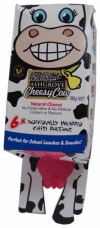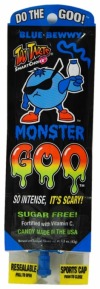Study: Packaging damage profoundly undermines sales, brand equity
Cities call for producer responsibility on packaging
2010 consumer packaging trends include color-coded containers
Aussie cheese package has a cow
Squeezable candy gets sports cap

By Rick Lingle
Executive Editor
Judging by the crowds and the energy level inside the halls, the Private Label Manufacturers Assn. trade show held the week of Nov. 15 just outside Chicago was in great shape, and for one very good reason: The industry is thriving even if the economy is not.
A recent poll of consumers showed that the quality of store brands is a big factor in keeping shoppers buying them. In a survey by GfK Custom Research North America, 9 in 10 shoppers agreed that the store brand products they buy are as good as or better than national brand products, and the same percentage said they will keep buying store brand products even as the economy picks up.
One PLMA packaging expert told me that he’s seeing a counter-trend whereby national brands are ramping up their packaging designs as a way to combat private labels’ gains. As the saying goes, fight fire with fire, with packaging serving as the fuel for the flames.
As a bonus, many of the PLMA booths offer complimentary sampling of vendors’ wares. Working through lunch has never been this enjoyable. Here are several packaging nuggets that I found as I grazed on the go and kept my eyes peeled:

ThermaSet PET containers from Liquid Container
Graphic Packaging Int’l.’s compact booth was jam-packed with packaging developments including a new bag-in-box format to replace plastic bottles, a paper-and-film-based, more sustainable alternative to thermoformed plastic clamshells used to contain wedge-shaped sandwiches sold through deli and vending channels, point-of-sale options, heat transfer labels, multiple microwave active packaging options, machines and more.
Absopure bottled water debuted its new Eco-Pak container that boasts a minimum of 10% post-consumer recycled content. The company’s potential future goals include 25% PCR content and reduced container weight, according to a manager. Shrink-wrapped trays of the filled bottles were shipping to Walmart not for sale, but to confirm the bottles’ durability in the supply chain.
Squeezable foods for fun and convenience, including baby foods, applesauce, and related products, were found at the booths of vendorEco-Containerand copackerLiberty Gold Fruit Co.The latter, a California-based private label packer, was pitching its 3.5-ounce stand-up pouches with a resealable, twist-off narrow profile cap. Eco-Container copacks the Dole Canada Squish’ems squeezable pouches with an oversize, kid-safe cap, as well as Plum brand baby food.
TOP DEVELOPMENTS
Study: Packaging damage profoundly undermines sales, brand equity
A study on packaging damage commissioned by MWV released during the PLMA trade show proved that damaged packaging has a profound effect on shoppers’ purchasing decisions. It was found that for a range of frozen packaged foods, three-quarters of shoppers pushed a damaged package aside in search of an undamaged one. Shoppers’ trust in a product or brand declines steeply when the package is damaged. Up to 55% of shoppers left the brand, with 36% opting to purchase another brand. Perception of a product as a “brand you trust” dropped from 73% to 41% when packages were even slightly damaged. The study also indicated a significant relationship between the quality of the packaging material and the likelihood of a package to sustain damage.
Cities call for producer responsibility on packaging
On Nov. 14 during its 86th gathering, the U.S. National League of Cities (NLC) adopted a resolution urging Congress to call for producer responsibility for managing discarded products and packaging. Product Stewardship–aka Extended Producer Responsibility, or EPR–holds product manufacturers primarily responsible for the life cycle impact of their products.
This initiative would transfer waste management costs from taxpayers to producers and consumers to compel innovation in more sustainable products and packaging. The resolution also urges Congress “to protect and support the ability of local and state governments to establish [EPR] legislation.”
“I was excited to support this resolution,” says NLC member Sandra Colvin Roy, Minneapolis, and a member of the NLC Energy, Environment and Natural Resources Committee. “The [EPR] policy harnesses the tremendous capacity of capitalism and turns it towards cleaning up our environment. Internalizing disposal costs in product prices will stimulate innovation and new ideas.”
2010 consumer packaging trends include color-coded containers
Mintel released Nov. 17 its consumer packaged goods trend predictions for 2010. One prediction: More manufacturers will color-code their products in 2010 to help consumers cut through the clutter to find their favorite cereal flavor or shampoo variety. Some 64% of Americans say they want color-coded packaging. Color coding also helps brands stand out on the shelf.
Another trend: With people feeling confused and skeptical about different companies' nutrition symbols, more manufacturers will respond with clean, clear facts on front-of-pack statements in 2010.
Also, the definition of "local" will expand, making it more practical for major companies to use and for mainstream shoppers to purchase, Mintel predicts. For example, in the UK, nearly half of shoppers buy British-made products when they can.
2010 consumer packaging trends include color-coded containers
Mintel released Nov. 17 its consumer packaged goods trend predictions for 2010. One prediction: More manufacturers will color-code their products in 2010 to help consumers cut through the clutter to find their favorite cereal flavor or shampoo variety. Some 64% of Americans say they want color-coded packaging. Color coding also helps brands stand out on the shelf.
Another trend: With people feeling confused and skeptical about different companies' nutrition symbols, more manufacturers will respond with clean, clear facts on front-of-pack statements in 2010.
Also, the definition of "local" will expand, making it more practical for major companies to use and for mainstream shoppers to purchase, Mintel predicts. For example, in the UK, nearly half of shoppers buy British-made products when they can.

NEW PACKAGES
Aussie cheese package has a cowPortioned cheese snacks in Australia come in a playful, cow-evoking package. Cheesy Cow individually wrapped cheese portions from Ashgrove Cheese come six to the package, which is a square litho-printed paperboard carton with graphics that include a cartoon cow face on the front. The theme is completed with a die-cut flap at the bottom that forms the cow’s legs and udder. The 6.4-ounce package retails for US$7.38.

A viscous candy for kids comes in flexible packaging with a resealable sports cap. Too Tarts Smart Choice Goo from Innovative Candy Concepts, Atlanta, is packaged in a 1.5-ounce squeeze pack made from gravure-printed multilayer film. A push-pull sports cap is protected by a flap with instructions. The product, part of an established Too Tarts Smart Choice Goo line, is sugar-free and fortified with Vitamin C.
